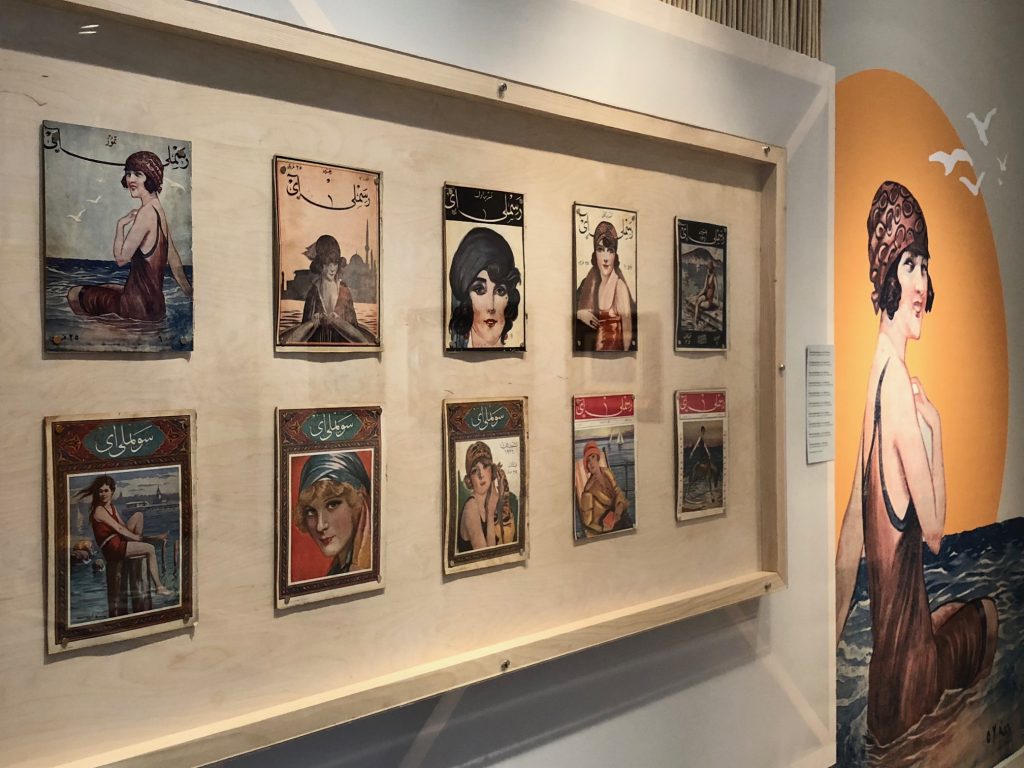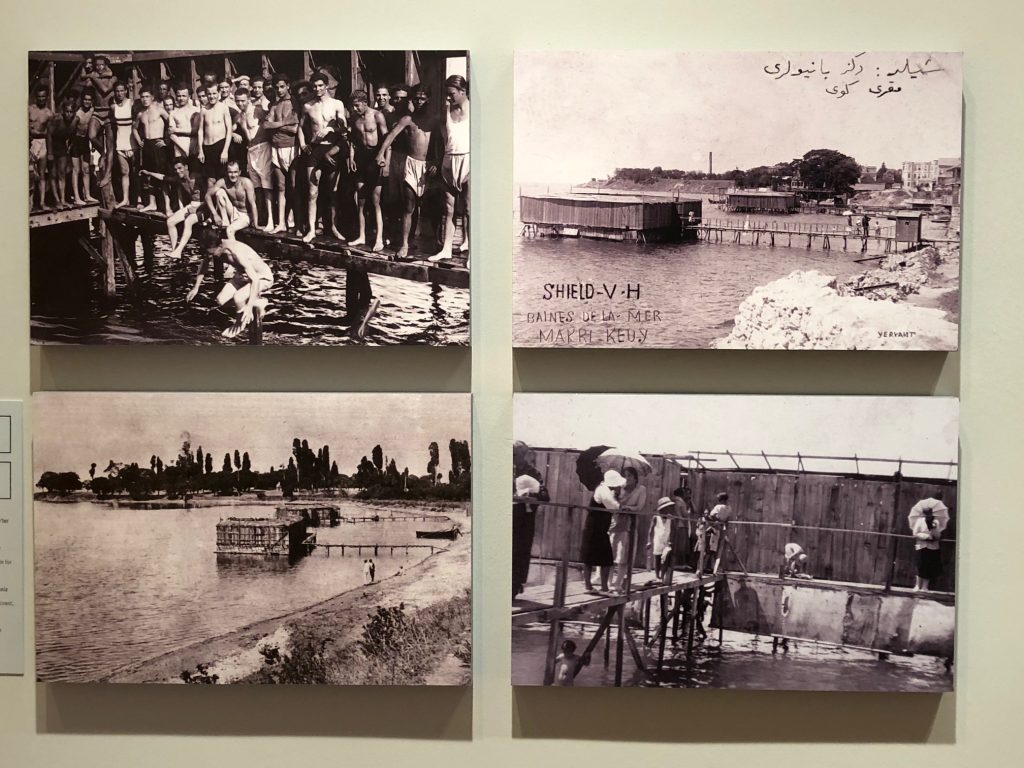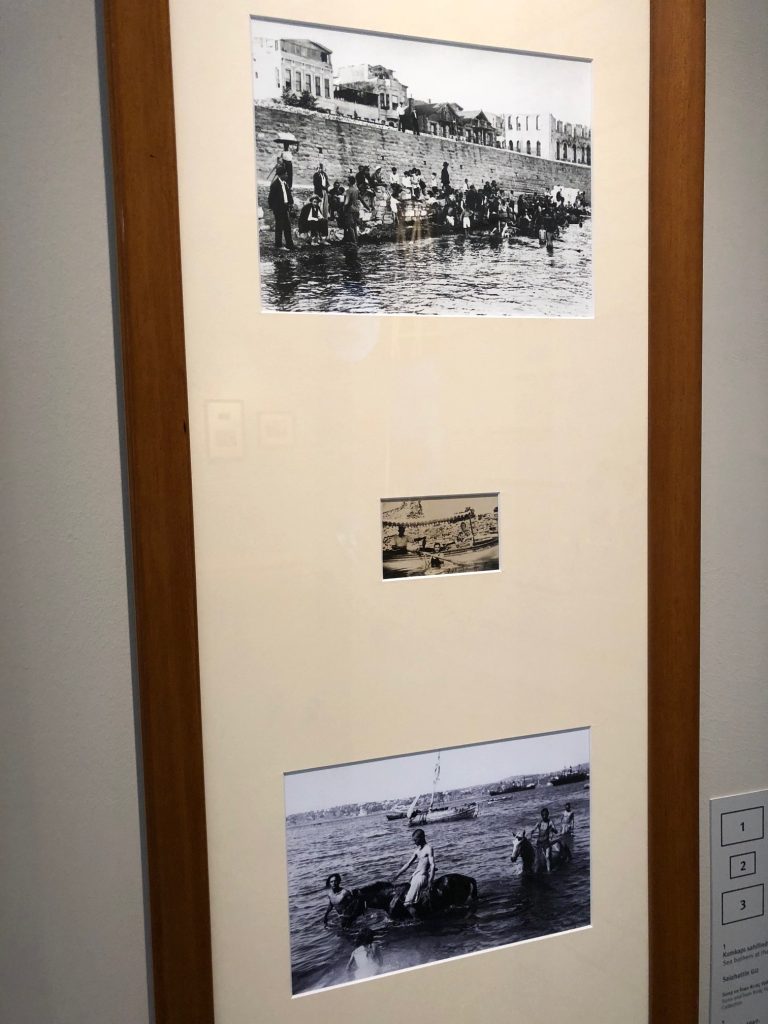This is my first visit to a Turkish museum, in Istanbul or elsewhere. When I went online to learn more on Istanbul’s museum scene, Pera Museum attracted my attention because of its classic posh architecture. Situated on the fancy “hilltop” Pera (now Beyoğlu), apparently this neighborhood held much weight in olden days. Tepebaşı used to be the center of the European side of Istanbul and many of the embassies and consulates resided there. Still holding quite a splendor, this area finds you surrounded by fancy buildings, hotels and restaurants. I barely recognized the museum’s building because it fit so well with the architecture of the surrounding French/Swiss residential buildings. It had apparently been conceived as a hotel itself and re-opened as a museum in 2005.
“Istanbul’s Seaside Leisure” is an ongoing exhibition on display through August of this year. It seemed to be a good place to start, since both summer and vacationing are upon us.

When you first enter the museum, it provides an aura of a hotel – with a reception and carpeted interiors and elevators standing opposite each other in the hallway. But that’s where the resemblance ends. The exhibition lies on the third and last floor of the museum, with the receptionist suggesting I start at the top and move down through the other exhibitions.
As you enter the elevators, you’re greeted with amazing retro pictures of girls in swimsuits. This instantly set me up with some high expectations and I wasn’t disappointed. Replicas of these pictures are also gigantically placed on the facade of the building; but being the oblivious tourist that I am, I only took notice going out. Go figure! The hallway of the third floor opens to rooms on the right and the left. Guided by a friendly security guard, I started on the right where the exhibition begins.
You are first struck by the bold orange color that is the theme of the exhibition. It’s not a common color to find in Istanbul’s street scene except on the slanted rooftops, which aren’t quite as striking as this color in the museum. It was very refreshing and summery! And from a purely energy/chakra perspective, orange is the color of the sacral/sex chakra, which incites creativity, activity and general alter-ness, which is what summer, beaches and sunshine are all about. Also quite striking is the creative use of beach set-ups and material. The exhibition is adorned with wooden huts, actual sand, and tables with old magazines on them, which sort of takes you back to old movies and you are suddenly teleported to a classic beach scene in the 30s. Chapeau bas, exhibition designers!

The essence of the exhibition depicts the evolution of the Istanbul beach scene over the years. On its walls, it starts with a couple of written synopses about what it was like to go to the beach before the turn of the 20th century and how it developed to what the young adults of today are used to seeing.
Like the majority of the world in the 18th and 19th century, going to the beach in our modern swimwear was unheard of. It was immodest and amoral to have people see bare parts of your body; male or female. But because the sea in Istanbul was basically everywhere, people started exploring. And wealthy people who owned houses and mansions on the Bosphorus started building what is known as “sea baths”. Those were square or round huts that stood in water and were bottomless from within. What you see from outside is a hut and nothing else. From the inside, there is a hole that looked like a pool but was actually the sea. People would bathe within the enclosure of these huts unseen by anyone outside. Because of the confined space in the hut, no one knew how to swim. There was no need really. Those holes acted like wading pools and opportunities to refresh yourself. Everyone was a non-swimmer except for military or navy personnel.
Those huts were – of course – segregated; women had their own huts, and men theirs. When time passed, those huts became more of a public option; they weren’t “elite only” anymore. And of course in time, the huts themselves became mixed. This as well resulted in the evolution of the swimsuit, for both genders. What you basically had as a more of a hamam attire, became more practical, body hugging and more skin started to appear.
Despite this whiff of modernity, going to the sea baths – and later the actual beach – was always an iffy situation. People feared water, the extra exposure to the sun, and sand! Doctors had to give instructions and procedures for going to the beach. The elderly and children especially had to take extra care when they ventured in. The exhibition has the doctor’s instructions printed on paper and stuck to the walls for the visitors to cut out and read. How creative is that! They – now – seem like satirical pieces of info but when you think about it, the sea was the unknown, baring of the skin was an oddity and the sand and sun were new, possibly dangerous territories!
Fast forward a few years, Istanbul has Atatürk! Now is the true age of modernity and quite quickly, the beach’s evolution is more of a sign of the shedding of older, more conservative views than an actual beach. People started approaching the seaside with zeal rather than fear and the younger generations started exploring the international scenes of summer and mimicking European models on magazine covers. You will see in the museum a wall of 10 or more magazine covers from the 20s and 30s of the 1900s, in which you basically can’t differentiate from the American and European specimen of that era. Atatürk himself started building his own seaside mansion in Istanbul and referred to it as basically the more fun abode. There’s even footage in the museum depicting him and his daughter literally “having fun in the sun”. They are adorable, if you ask me, and makes you see the country’s direction or at least role models promoting a different lifestyle and literally more freedom.

Prior to Atatürk’s beach and rowing scenes, the museum postulates that the attraction and the change in the seaside scene was due to the advent of the Russian who had migrated to Istanbul after their revolution. They brought that sense of adventure, fun and mostly fashion to Istanbul in a major way. Suddenly the seaside was filled with bikinis, shorter trunks and people having sand baths! So instead of seeing the sand as a threat, the Russians were buried in it. How progressive!
The museum is filled with interactive and visual aids as well as beautiful black and white photos that really do tell of a time only imaginable through them. It’s definitely worth visiting because of the above and more.
I wonder what a museum in the year 3100 would show of today’s “modern” seaside. We’ll never know, but we certainly have come a long way in a century.
All images courtesy of the author.









